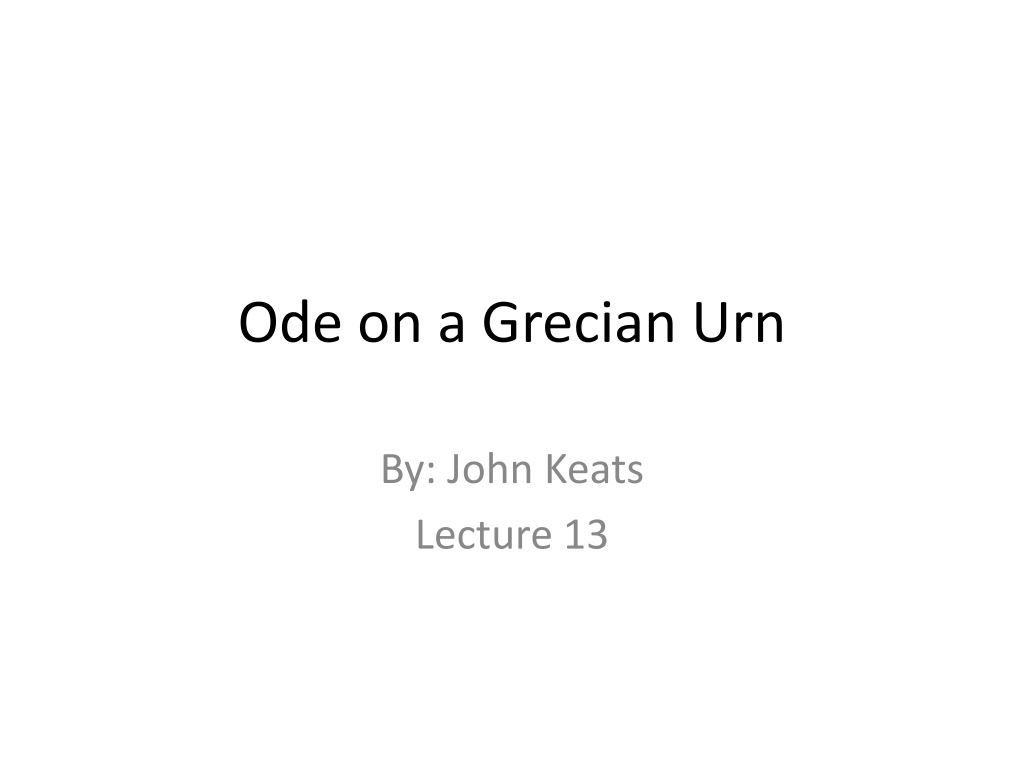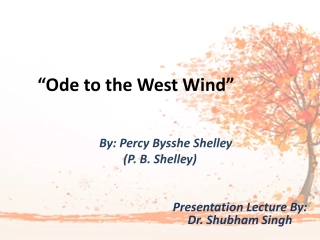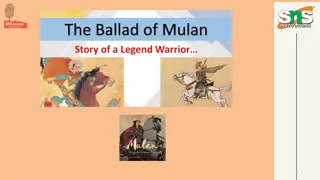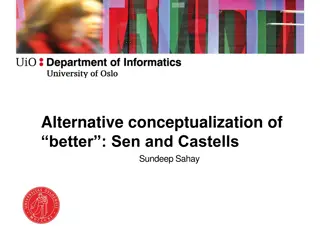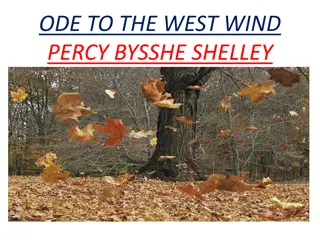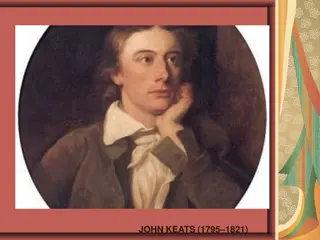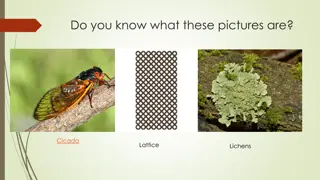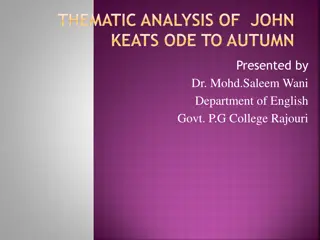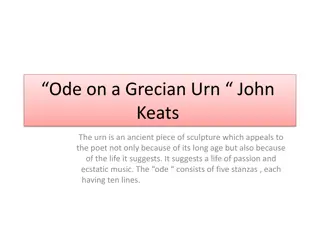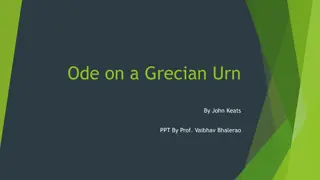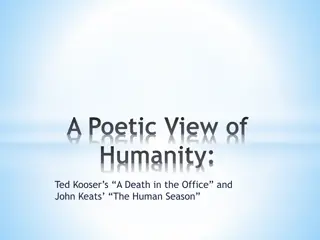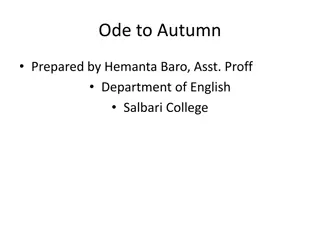Exploring John Keats's Negative Capability Theory in "Ode on a Grecian Urn
John Keats, known for his melancholic temperament, delved into the concept of Negative Capability in his poetry, particularly evident in "Ode on a Grecian Urn." This theory emphasizes the poet's ability to transcend rationality and immerse in intense emotions without the need for analysis or judgment. Keats believed that through Negative Capability, one could achieve a heightened sense of beauty and truth in art, allowing the object of focus to symbolize profound emotions.
Download Presentation

Please find below an Image/Link to download the presentation.
The content on the website is provided AS IS for your information and personal use only. It may not be sold, licensed, or shared on other websites without obtaining consent from the author. Download presentation by click this link. If you encounter any issues during the download, it is possible that the publisher has removed the file from their server.
E N D
Presentation Transcript
Ode on a Grecian Urn By: John Keats Lecture 13
About Keats Keats was of melancholic temperament which was brought about by his experiences of human suffering as dresser at Guy Hospital and his own personal losses and deaths in family. He died at the age of 25, had only 54 poems published out of 150 poems that he wrote. His poetry is characterized by sensual imagery especially in the odes.
Major themes in his works are: transience of life & the inevitability of death, contemplation of Beauty, Hellenism, reverie & getting lost in the ideal world, his negative capability, sensuous imagery & permanence of art. He had plans of poetic achievement but his dream was always interrupted by thoughts of approaching death. In many of his poems the speaker leaves the real world to explore a mythical or aesthetic realm and returns at the end with better understanding.
Negative Capability The ability to get lost in a reverie, to leave conscious life for imaginative life without wondering about rationality is Keats concept of negative capability. The poet gives up his personal identity to focus on object being described, so the object becomes symbolic of intense emotions and only that emotion is important. Keats rejected the artist s attempt to analyze, rationalize, or categorize the world to pass judgments.
Negative Capability Also described as aesthetic objectivity Keats theory of negative capability is concerned with particular state of poetic receptivity that makes literary creation possible. In a letter to his brother George in Dec 1817, he contends: the excellence of every Art is its intensity, capable of making all disagreeables evaporate, from their being in close relationship with beauty & truth I mean Negative Capability, that is when man is capable of being in uncertainties, Mysteries, doubts, without any irritable reaching after fact & reason with a great poet the sense of Beauty overcomes every other consideration, or rather obliterates all consideration.
Negative Capability Therefore, Keats theory breaks down as the following: Imagination communicates an intense emotion. The poet gives up personal identity to focus on the object being described. As a result, the object becomes symbolic of these intense emotions. And all other matters not important to this emotion are sidelined. The poem s beauty/truth are combination of poetic emotion and perceived object. The poem thus is a subjective truth.
About the Ode For Keats therefore, the urn in Ode to a Grecian Urn is an object that speaks a truth and a beauty, but that truth and beauty are understood by the negative capability of the artist. The urn s message of beauty and truth, thus is open- ended and mysterious. The ode contains the most discussed two lines of all of Keats poetry Beauty is truth, truth beauty-that is all/Ye know on earth, and all ye need to know.
About the Ode It is the third of the five great odes of 1819, which are generally believed to have been written in the following order Psyche, Nightingale, Grecian Urn, Melancholy, and Autumn. He conveys his philosophy about art, beauty and love. Written in ten line stanzas in iambic pentameter with a rhyme scheme of abab cde cde, and is thus Horatian (ode with one stanza type).
Stanza 1 Thou still unravish'd bride of quietness, Thou foster-child of silence and slow time, Poet addresses the urn, he is preoccupied with the pictures on the urn. He imagines a permanent state of unconsumed passion. Unravished bride of quiteness: a new bride Foster child of silence & slow time: sense of timelessness & frozen time
Sylvan historian, who canst thus express A flowery tale more sweetly than our rhyme: Sylvan historian: is a bearer of history, can tell a story Our rhyme: our poem or song
What leaf-fring'd legend haunts about thy shape Of deities or mortals, or of both, In Tempe or the dales of Arcady? The urn is decorated with vines covered in leaves, hence the story of the urn is hidden behind the curtain of leaves. Tale is about gods or humans or both. Tempe or Arcady: valley in Greece
What men or gods are these? What maidens loth? What mad pursuit? What struggle to escape? What pipes and timbrels? What wild ecstasy? Describes different scenes etched on the urn. Loth: loath Timbrels: small drums Pipes: flute Wild ecstasy: extreme emotion of joy and complete surrender to the state
Stanza 2 Heard melodies are sweet, but those unheard Are sweeter; therefore, ye soft pipes, play on; The unheard songs are sweeter because they are unaffected by time, The musicians playing flute are asked to play on since their music is for the soul.
Not to the sensual ear, but, more endear'd, Pipe to the spirit ditties of no tone: Sensual ear: physical ear Endear d: loved Pipe : play on Ditties: short songs
Fair youth, beneath the trees, thou canst not leave Thy song, nor ever can those trees be bare; A young lad lying under the tree is singing for his beloved and must go on singing. The trees above will never experience autumn and death.
Bold Lover, never, never canst thou kiss, Though winning near the goal yet, do not grieve; The lover attempting to kiss his beloved will never be able to do so. His love forever will remain unfulfilled.
She cannot fade, though thou hast not thy bliss, For ever wilt thou love, and she be fair! Tells the beloved to take strength from the fact that she will always be there beside him, though his love never consumed. She will always remain beautiful and you will always love her.
Stanza 3 Ah, happy, happy boughs! that cannot shed Your leaves, nor ever bid the Spring adieu; The branches will forever be green. Keats envies them their lasting happiness and fertility and beauty.
And, happy melodist, unwearied, For ever piping songs for ever new; The musician will never stop playing and his songs will always be new for new generations of humans. It stays forever while a generation of humans is replaced by another, so in this way the beauty or music of the urn stays fresh and forever new.
More happy love! more happy, happy love! For ever warm and still to be enjoy'd, For ever panting, and for ever young; Love is always happy and never changing.
All breathing human passion far above, That leaves a heart high-sorrowful and cloy'd, A burning forehead, and a parching tongue. The love of the world of mortals is inconsistent and short-lived and dies too soon.
Stanza 4 Who are these coming to the sacrifice? To what green altar, O mysterious priest, Scene of sacrfice and offering at the altar a religious ceremony.
Lead'st thou that heifer lowing at the skies, And all her silken flanks with garlands drest? A young ram being led to the altar for sacrifice. The body is covered and decorated with flowers, as is done with sacrificial animals.
What little town by river or sea shore, Or mountain-built with peaceful citadel, Is emptied of this folk, this pious morn? Picture of a deserted village people may have gone for sacrifice Citadel: fortress Pious morn: holy morning
And, little town, thy streets for evermore Will silent be; and not a soul to tell Why thou art desolate, can e'er return. The picture of silence will never change, the village never be full of people, they will never return to tell their tales. The desolate village will remain desolate sense of deep meditation
Stanza 5 O Attic shape! Fair attitude! with brede Of marble men and maidens overwrought, With forest branches and the trodden weed; Shape in ancient Greek city, Attica. Fair attitude: abstract form Brede: braid, interwoven design Overwrought: decorated
Thou, silent form, dost tease us out of thought As doth eternity: Cold Pastoral! Silent form: reminder of bride of quiteness Tease us out of thought: baffle us, confuse us The silence of the urn leads man to thoughts of eternity or life after death, and hence Keats calls it cold pastoral . The urn is unconcerned with the plight of humans/mortals .
When old age shall this generation waste, Thou shalt remain, in midst of other woe Than ours, a friend to man, to whom thou say'st, The urn induces deep thoughts of the fate of mankind: the ultimate death and replacement of one generation with another. But the poet feels that the urn will keep giving lessons to all generations of mankind.
"Beauty is truth, truth beauty,that is all Ye know on earth, and all ye need to know." This, in the words of Keats, is the message of the urn to all generations of mankind. That beauty and truth cannot be separated, in the words of Emily Legouis beauty is the only higher truth,
